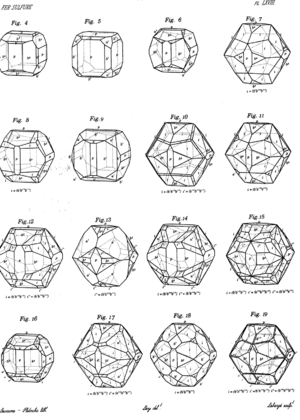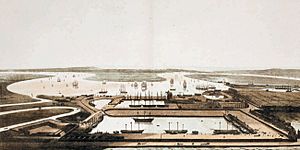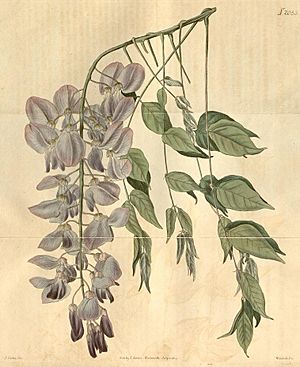Charles Turner (merchant) facts for kids
Charles Hampden Turner (born 1772, died 1856) was a British businessman. Today, he is mostly remembered for his amazing collections and his passion for gardening.
Contents
Charles Hampden Turner: A Life of Business and Discovery
Early Life and Business Ventures
Charles Hampden Turner was born in 1772. His father, John Turner, was a sailmaker from Limehouse, London. Charles went to Merchant Taylors School in London.
He first owned a company that made sails and canvas in Limehouse. Later, in 1800, he joined a local business that made ropes, called cordage. He partnered with Joseph Huddart, John Woolmore, and Sir Robert Wigram. By 1809, he stopped working for the government as an inspector of canvas because his other businesses were too busy.
Connecting with Important People
A young man named William Cotton started working for Turner's company when he was 15. In 1807, he became a partner in Huddart & Co. William's father, Joseph Cotton, was also a business friend of Turner's. Joseph was the chairman of the East India Docks Company, and Turner was the deputy chairman. In 1814, Turner even spoke to Parliament about shipping for the East India Company. He also led the group that built the East India Dock Road.
Turner also worked with famous engineers. In 1820, James Walker suggested a trial trip for a steam vessel (a boat powered by steam) from London to Edinburgh. This trip happened in June 1821 on a ship called the City of Edinburgh. After the famous inventor James Watt died in 1819, his son, James Watt junior, asked friends to help remember his father. Turner was a key person in this effort. He led a committee in 1824 that helped pay for a memorial statue of Watt.
A Man of Many Interests
Charles Hampden Turner was interested in many different fields. He became a member of the Geological Society in 1813, which studies rocks and the Earth. In 1819, he joined the Linnean Society, which focuses on plants and animals. Then, in 1821, he became a member of the important Royal Society.
He also served as the High Sheriff of Surrey in 1823, which was an important local role. He was a member of the Horticultural Society, which is all about gardening. He also belonged to the Royal Institution and the Athenaeum Club, which were places where smart people met. In 1848, he became an honorary member of the Society of Civil Engineers.
His Home and Amazing Garden
Rook's Nest: A Special House
In 1817, Turner bought a house called "Rook's Nest" in Surrey. It came with 140 acres of land. The house was described as a "stately" (grand) mansion with a classic design. Inside, it had busts (sculptures of heads and shoulders) of James Watt and John Rennie, another famous engineer. It also had a portrait of Joseph Huddart, his business partner.
Bringing Wisteria to Britain
Turner was very passionate about gardening. He is famous for helping to bring the beautiful Chinese wisteria plant (Wisteria sinensis) to the United Kingdom. Around 1810, a captain named Robert Welbank brought a type of Camellia japonica flower for Turner.
In May 1816, Captain Welbank, sailing on a ship called the Cuffnells, brought a wisteria plant to Turner as a gift. This plant might have been sent by John Reeves, who worked in China. Reeves definitely sent another wisteria plant to Kew Gardens in 1818. The wisteria plant originally came from Zhangzhou in China.
Another captain, Richard Rawes, also brought wisteria from the same garden in China. This plant went to a different gardener, Thomas Carey Palmer.
How the Wisteria Bloomed
Turner first kept his wisteria plant in its pot. He was a pioneer in using steam heating for his conservatories (special greenhouses). He put his wisteria in a peach house where it was very warm (about 84°F). Then, his gardener repotted it and moved it to a cooler, shady greenhouse. The plant started to flower in March 1819!
Turner's success with the wisteria earned him a medal from the Horticultural Society. He had his wisteria plants grown by a nursery called Messrs. Loddiges. Later, he switched to a water heating method for his greenhouses.
His Fascinating Collections
Art and Letters
Turner also collected art. He received many small paintings called miniatures from William Upcott in 1845. He also collected works by his friend, the painter George Jones. He especially liked Jones's drawings of battles and his sketches.
Around 1827, Turner borrowed letters from the Warde family. These letters were written by James Wolfe, a famous general. Turner lent them to Robert Southey, who was planning to write a book about Wolfe.

The Famous Mineral Collection
Turner owned a very important collection of minerals. This collection was originally started by Jacob Forster and then built up by Henri Heuland. Turner bought it from Heuland between 1806 and 1820.
In 1837, a detailed book was published about Turner's mineral collection. It was called Description d'une collection de minéraux, formée par M. Henri Heuland, et appartenant a M. Ch. Hampden Turner, written by Armand Lévy. As a compliment to Turner, Lévy even named a rare mineral "turnerite" after him! Later, in 1866, this mineral was identified as monazite.
After Turner, the collection was bought by Henry Ludlam. Eventually, it became part of the Museum of Practical Geology.
His Family
Charles Hampden Turner married Mary Rohde. They had one son, also named Charles Hampden. This son went to Christ Church, Oxford and later married Henrietta-Fourness. Sadly, he died in 1842, leaving behind a son who became a soldier.
Turner and Mary also had two daughters. Their daughter Mary married Money Wigram, who was the son of Sir Robert Wigram, Turner's business partner. Their second daughter, Harriet, married Rev. Thomas Staniforth in 1837.



